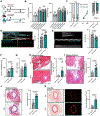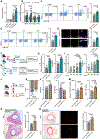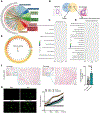Perivascular Fibrosis Is Mediated by a KLF10-IL-9 Signaling Axis in CD4+ T Cells
- PMID: 35440172
- PMCID: PMC9149118
- DOI: 10.1161/CIRCRESAHA.121.320420
Perivascular Fibrosis Is Mediated by a KLF10-IL-9 Signaling Axis in CD4+ T Cells
Abstract
Background: Perivascular fibrosis, characterized by increased amount of connective tissue around vessels, is a hallmark for vascular disease. Ang II (angiotensin II) contributes to vascular disease and end-organ damage via promoting T-cell activation. Despite recent data suggesting the role of T cells in the progression of perivascular fibrosis, the underlying mechanisms are poorly understood.
Methods: TF (transcription factor) profiling was performed in peripheral blood mononuclear cells of hypertensive patients. CD4-targeted KLF10 (Kruppel like factor 10)-deficient (Klf10fl/flCD4Cre+; [TKO]) and CD4-Cre (Klf10+/+CD4Cre+; [Cre]) control mice were subjected to Ang II infusion. End point characterization included cardiac echocardiography, aortic imaging, multiorgan histology, flow cytometry, cytokine analysis, aorta and fibroblast transcriptomic analysis, and aortic single-cell RNA-sequencing.
Results: TF profiling identified increased KLF10 expression in hypertensive human subjects and in CD4+ T cells in Ang II-treated mice. TKO mice showed enhanced perivascular fibrosis, but not interstitial fibrosis, in aorta, heart, and kidney in response to Ang II, accompanied by alterations in global longitudinal strain, arterial stiffness, and kidney function compared with Cre control mice. However, blood pressure was unchanged between the 2 groups. Mechanistically, KLF10 bound to the IL (interleukin)-9 promoter and interacted with HDAC1 (histone deacetylase 1) inhibit IL-9 transcription. Increased IL-9 in TKO mice induced fibroblast intracellular calcium mobilization, fibroblast activation, and differentiation and increased production of collagen and extracellular matrix, thereby promoting the progression of perivascular fibrosis and impairing target organ function. Remarkably, injection of anti-IL9 antibodies reversed perivascular fibrosis in Ang II-infused TKO mice and C57BL/6 mice. Single-cell RNA-sequencing revealed fibroblast heterogeneity with activated signatures associated with robust ECM (extracellular matrix) and perivascular fibrosis in Ang II-treated TKO mice.
Conclusions: CD4+ T cell deficiency of Klf10 exacerbated perivascular fibrosis and multi-organ dysfunction in response to Ang II via upregulation of IL-9. Klf10 or IL-9 in T cells might represent novel therapeutic targets for treatment of vascular or fibrotic diseases.
Keywords: Kruppel like factor 10 (KLF10); T cell; angiotensin II (Ang II); interleukins (IL)-9; perivascular fibrosis.
Figures








References
-
- Wu J, Saleh MA, Kirabo A, Itani HA, Montaniel KR, Xiao L, Chen W, Mernaugh RL, Cai H, Bernstein KE, Goronzy JJ, Weyand CM, Curci JA, Barbaro NR, Moreno H, Davies SS, Roberts LJ, Madhur MS, Harrison DG. Immune activation caused by vascular oxidation promotes fibrosis and hypertension. J Clin Invest. 2016;126:1607 - PMC - PubMed
-
- Lewington S, Clarke R, Qizilbash N, Peto R, Collins R. Age-specific relevance of usual blood pressure to vascular mortality: A meta-analysis of individual data for one million adults in 61 prospective studies. Lancet. 2002;360:1903–1913 - PubMed
Publication types
MeSH terms
Substances
Grants and funding
LinkOut - more resources
Full Text Sources
Medical
Molecular Biology Databases
Research Materials
Miscellaneous

